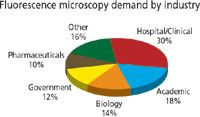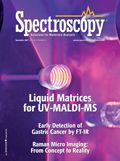Market Profile: Fluorescence Microscopy
Although overshadowed by other technologies, demand for fluorescence microscopy is already strong and is growing rapidly. The technology is proving to be very useful for specific life science applications.
Although overshadowed by other technologies, demand for fluorescence microscopy is already strong and is growing rapidly. The technology is proving to be very useful for specific life science applications.
Confocal microscopy is one of the standard tools of the traditional laboratory. Although the addition of visual imaging systems on top of the manual microscope added an additional capability, the integration of fluorescence imaging into such instruments provides a very informative secondary dimension. The technique not only provides an image of the relative distribution and concentrations of fluorescent compounds within a specimen, but also can provide spectral data on each point in the image. A fluorescence microscopy or imaging system can also be tuned to display only a specific protein, or the relative concentrations of a certain protein or compound can be profiled. Often, fluorescent compounds or "tags" are added to the specimen to provide the needed contrast, which may not be observable the in the visual spectrum.

Fluorescence microscopy demand by industry
The applications of fluorescent imaging are centered on biological research, such as neuroscience and cell biology. The technique offers the ability to image and analyze living cells, which often can provide invaluable information. Stem cell research is a particularly hot area of growth.
The worldwide market for fluorescence microscopy was worth well over $100 million in 2006. Demand will continue to grow at well over 10% annually due to the steady stream of new instruments that have continued to be introduced.
The foregoing data were based on SDi's market analysis and perspectives report entitled Edition Global Assessment Report, 9th Edition: The Laboratory Life Science and Analytical Instrument Industry, September 2006. For more information, contact Stuart Press, Senior Consultant, Strategic Directions International, Inc., 6242 Westchester Parkway, Suite 100, Los Angeles, CA 90045, (310) 641-4982, fax: (310) 641-8851, www.strategic-directions.com.

New Study Reveals Insights into Phenol’s Behavior in Ice
April 16th 2025A new study published in Spectrochimica Acta Part A by Dominik Heger and colleagues at Masaryk University reveals that phenol's photophysical properties change significantly when frozen, potentially enabling its breakdown by sunlight in icy environments.
Tracking Molecular Transport in Chromatographic Particles with Single-Molecule Fluorescence Imaging
May 18th 2012An interview with Justin Cooper, winner of a 2011 FACSS Innovation Award. Part of a new podcast series presented in collaboration with the Federation of Analytical Chemistry and Spectroscopy Societies (FACSS), in connection with SciX 2012 ? the Great Scientific Exchange, the North American conference (39th Annual) of FACSS.
Can Fluorescence Spectroscopy Evaluate Soil Dissolved Organic Matter Dynamics?
February 20th 2025A new study published in Chemical Engineering Journal by researchers from Northeast Agricultural University in China reveals that biochar aging, influenced by environmental factors like UV exposure and wet-dry cycles, alters dissolved organic matter composition and affects its effectiveness in remediating cadmium-contaminated soil.
New Fluorescent Raman Technique Enhances Detection of Microplastics in Seawater
November 19th 2024A novel method using fluorescence labeling and differential Raman spectroscopy claims to offer a more efficient, accurate approach to detect microplastics in seawater. Developed by researchers at the Ocean University of China, this method improves both the speed and precision of microplastic identification, addressing a key environmental issue affecting marine ecosystems.